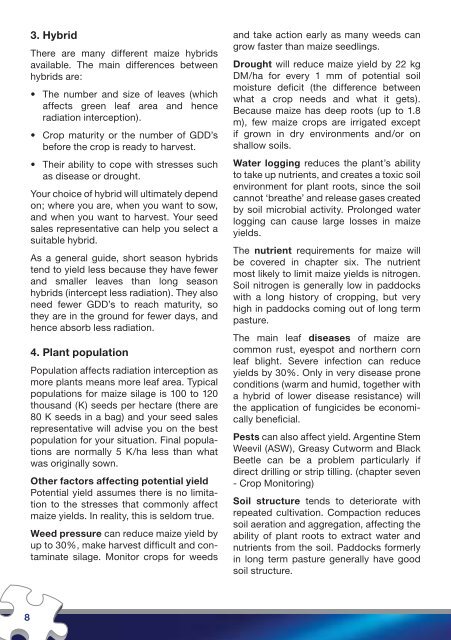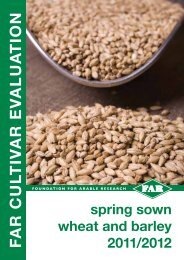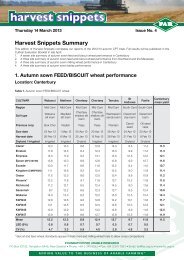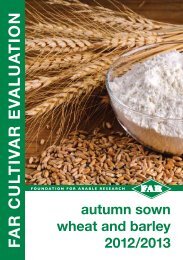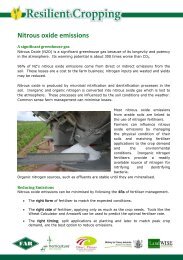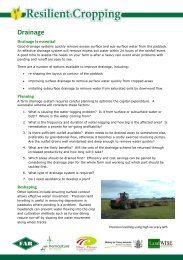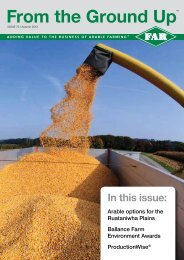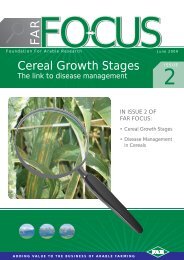Best Management Practices for Growing Maize on Dairy Farms
Best Management Practices for Growing Maize on Dairy Farms
Best Management Practices for Growing Maize on Dairy Farms
- No tags were found...
You also want an ePaper? Increase the reach of your titles
YUMPU automatically turns print PDFs into web optimized ePapers that Google loves.
3. HybridThere are many different maize hybridsavailable. The main differences betweenhybrids are:• The number and size of leaves (whichaffects green leaf area and henceradiati<strong>on</strong> intercepti<strong>on</strong>).• Crop maturity or the number of GDD’sbe<str<strong>on</strong>g>for</str<strong>on</strong>g>e the crop is ready to harvest.• Their ability to cope with stresses suchas disease or drought.Your choice of hybrid will ultimately depend<strong>on</strong>; where you are, when you want to sow,and when you want to harvest. Your seedsales representative can help you select asuitable hybrid.As a general guide, short seas<strong>on</strong> hybridstend to yield less because they have fewerand smaller leaves than l<strong>on</strong>g seas<strong>on</strong>hybrids (intercept less radiati<strong>on</strong>). They als<strong>on</strong>eed fewer GDD’s to reach maturity, sothey are in the ground <str<strong>on</strong>g>for</str<strong>on</strong>g> fewer days, andhence absorb less radiati<strong>on</strong>.4. Plant populati<strong>on</strong>Populati<strong>on</strong> affects radiati<strong>on</strong> intercepti<strong>on</strong> asmore plants means more leaf area. Typicalpopulati<strong>on</strong>s <str<strong>on</strong>g>for</str<strong>on</strong>g> maize silage is 100 to 120thousand (K) seeds per hectare (there are80 K seeds in a bag) and your seed salesrepresentative will advise you <strong>on</strong> the bestpopulati<strong>on</strong> <str<strong>on</strong>g>for</str<strong>on</strong>g> your situati<strong>on</strong>. Final populati<strong>on</strong>sare normally 5 K/ha less than whatwas originally sown.Other factors affecting potential yieldPotential yield assumes there is no limitati<strong>on</strong>to the stresses that comm<strong>on</strong>ly affectmaize yields. In reality, this is seldom true.Weed pressure can reduce maize yield byup to 30%, make harvest difficult and c<strong>on</strong>taminatesilage. M<strong>on</strong>itor crops <str<strong>on</strong>g>for</str<strong>on</strong>g> weedsand take acti<strong>on</strong> early as many weeds cangrow faster than maize seedlings.Drought will reduce maize yield by 22 kgDM/ha <str<strong>on</strong>g>for</str<strong>on</strong>g> every 1 mm of potential soilmoisture deficit (the difference betweenwhat a crop needs and what it gets).Because maize has deep roots (up to 1.8m), few maize crops are irrigated exceptif grown in dry envir<strong>on</strong>ments and/or <strong>on</strong>shallow soils.Water logging reduces the plant’s abilityto take up nutrients, and creates a toxic soilenvir<strong>on</strong>ment <str<strong>on</strong>g>for</str<strong>on</strong>g> plant roots, since the soilcannot ‘breathe’ and release gases createdby soil microbial activity. Prol<strong>on</strong>ged waterlogging can cause large losses in maizeyields.The nutrient requirements <str<strong>on</strong>g>for</str<strong>on</strong>g> maize willbe covered in chapter six. The nutrientmost likely to limit maize yields is nitrogen.Soil nitrogen is generally low in paddockswith a l<strong>on</strong>g history of cropping, but veryhigh in paddocks coming out of l<strong>on</strong>g termpasture.The main leaf diseases of maize arecomm<strong>on</strong> rust, eyespot and northern cornleaf blight. Severe infecti<strong>on</strong> can reduceyields by 30%. Only in very disease pr<strong>on</strong>ec<strong>on</strong>diti<strong>on</strong>s (warm and humid, together witha hybrid of lower disease resistance) willthe applicati<strong>on</strong> of fungicides be ec<strong>on</strong>omicallybeneficial.Pests can also affect yield. Argentine StemWeevil (ASW), Greasy Cutworm and BlackBeetle can be a problem particularly ifdirect drilling or strip tilling. (chapter seven- Crop M<strong>on</strong>itoring)Soil structure tends to deteriorate withrepeated cultivati<strong>on</strong>. Compacti<strong>on</strong> reducessoil aerati<strong>on</strong> and aggregati<strong>on</strong>, affecting theability of plant roots to extract water andnutrients from the soil. Paddocks <str<strong>on</strong>g>for</str<strong>on</strong>g>merlyin l<strong>on</strong>g term pasture generally have goodsoil structure.8


